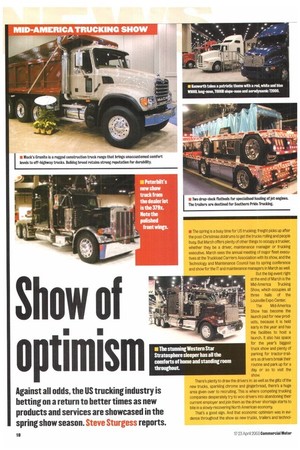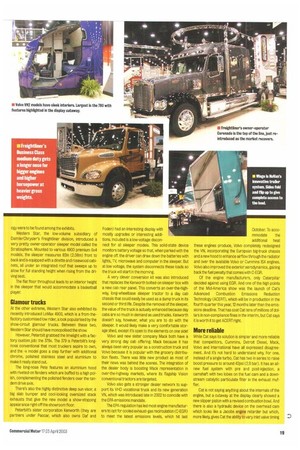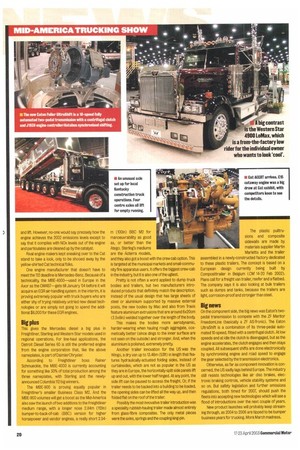Show of optimis
Page 18

Page 19

Page 20

If you've noticed an error in this article please click here to report it so we can fix it.
Against all odds, the US trucking industry is betting on a return to better times as new products and services are showcased in the spring show season. Steve Sturgess reports.
• The spring is a busy time for US trucking: freight picks up after the post-Christmas doldrums to get the trucks rolling and people busy. But March offers plenty of other things to occupy a trucker, whether they be a driver, maintenance manager or trucking executive. March sees the annual meeting of major fleet executives at the Truckload Carriers Association with its show, and the Technology and Maintenance Council has its spring conference and show for the IT and maintenance managers in March as well.
But the big event right at the end of March is the Mid-America Trucking Show, which occupies all three halls of the Louisville Expo Center.
The Mid-America Show has become the !ram launch pad for new products, because it is held early in the year and has the facilities to host a launch. It also has space for the year's biggest truck show and plenty of parking for tractor-trailers as drivers break their routine and park up for a day or so to visit the show.
There's plenty to draw the drivers in: as well as the glitz of the new trucks, sparkling chrome and gingerbread, there's a huge area given over to recruiting. This is where competing trucking companies desperately try to woo drivers into abandoning their current employer and join them as the driver shortage starts to bite in a slowly-recovering North American economy, That's a good sign. And that economic optimism was in evidence throughout the show as new trucks, trailers and technol
ogy were to be found among the exhibits.
Western Star, the low-volume subsidiary of DaimlerChrysler's Freightliner division, introduced a very pretty owner-operator sleeper model called the Stratosphere. Mounted to various 4900 premium 6x4 models, the sleeper measures 82in (2.08m) front to back and is equipped with a dinette and rosewood cabinets, all under an integrated roof that sweeps up to allow for full standing height when rising from the driving seat.
The flat floor throughout leads to an interior height in the sleeper that would accommodate a basketball player.
Glamour trucks
At the other extreme, Western Star also exhibited its recently introduced LoMax 4900, which is a from-thefactory customised low rider, a look popularised by the show-circuit glamour trucks. Between these two, Western Star should have monopolised the show.
However, Peterbilt grabbed the limelight with a factory custom job: the 379x. The 379 is Peterbitt's longnose conventional that most truckers aspire to own, and the -x model goes a step further with additional chrome, polished stainless steel and aluminium to make it really stand out.
The long-nose Pete features an aluminium hood with riveted-on fenders which are buffed to a high polish, complementing the polished fenders over the tandem drive axle.
There's also the highly distinctive deep sun visor, a big slab bumper and cool-looking oversized stack exhausts that give the new model a show-stopping appearance right off the showroom floor.
Peterbilt's sister corporation Kenworth (they are partners under Paccar, which also owns Oaf and Foden) had an interesting display with mostly upgrades or interesting addi tions. Included is a low-voltage discon
nect for all sleeper models. This solid-state device monitors battery voltage so that, when parked with the engine off, the driver can draw down the batteries with lights, TV, microwave and computer in the sleeper. But at low voltage, the system disconnects these loads so the truck will start in the morning.
A very clever conversion kit was also introduced that replaces the Kenworth bolted-on sleeper box with a new cab rear panel. This converts an over-the-highway, long-wheelbase sleeper tractor to a day cab chassis that could easily be used as a dump truck in its second or third life. Despite the removal of the sleeper, the value of the truck is actually enhanced because day cabs are so much in demand as used trucks. Kenworth doesn't say, however, what you are to do with the sleeper. It would likely make a very comfortable storage shed, except it's open to the elements on one side!
Volvo and new sister company Mack both have a very strong day cab offering; Mack because it has always been very popular as a construction truck and Volvo because it is popular with the grocery distribution fleets. There was little new product as most of their news was behind the scenes. The integration of the dealer body is boosting Mack representation in over-the-highway markets, where its flagship Vision conventional tractors are targeted.
Volvo also gets a stronger dealer network to support its VHD vocational truck and its new generation VN, which was introduced late in 2002 to coincide with the EPA emissions mandate.
The EPA regulation has led most engine manufacturers to opt for cooled exhaust-gas recirculation (C-EGR) to meet the latest emissions levels, which hit last
October. To acco mmodate the additional heat these engines produce, Volvo completely redesigned the VN, incorporating the European big-truck chassis and a new hood to enhance airflow through the radiator and over the available Volvo or Cummins ISX engines. Volvo also improved the exterior aerodynamics, gaining back the fuel penalty that comes with C-EGR.
Of the engine manufacturers, only Caterpillar decided against using EGR. And one of the high points of the Mid-America show was the launch of Cat's Advanced Combustion Emissions Reduction Technology (ACERT), which will be in production in the fourth quarter this year, 12 months later than the emissions deadline. That has cost Cat tens of millions of dollars in non-compliance fines in the interim, but Cat says it is worth it to get ACERT right.
More reliable
While Cat says its solution is simpler and more reliable that competitors, Cummins, Detroit Diesel, Mack, Volvo and International have all expressed disagreement. And it's not hard to understand why. For one, instead of a single turbo, Cat has two in series to raise boost pressure to around 42psi (2.9 bar). tt has an allnew fuel system with pre and post-injection, a camshaft with two lobes on the fuel cam and a downstream catalytic particulate filter in the exhaust muffler.
Cat is not saying anything about the internals of the engine, but a cutaway at the display clearly showed a new slipper piston with a revised combustion bowl. And there is also a hydraulic device on the overhead cam which looks like a Jacobs engine retarder but which, more likely, gives Cat the ability to vary inlet valve timing and lift. However, no-one would say precisely how the engine achieves the 2002 emissions levels except to say that it complies with NOx levels out of the engine and particulates are cleaned up by the catalyst.
Rival engine makers kept sneaking over to the Cat stand to take a look, only to be shooed away by the yellow-shirted Cat technical folks.
One engine manufacturer that doesn't have to meet the 02 deadline is Mercedes-Benz. Because of a technicality, the MBE-4000—used in Europe in the Axor as the 0M457—gets till January 04 before it will acquire an EGR air-handling system. In the interim, it is proving extremely popular with truck buyers who are either shy of trying relatively untried new diesel technologies or are simply not going to spend the additional $6,000 for these EGA engines.
Big plus This gives the Mercedes diesel a big plus in Freightliner, Sterling and Western Star models used in regional operations. For line-haul applications, the Detroit Diesel Series 60 is still the preferred engine from the engine corporation that, like the above nameplates, is part of DaimlerChrysler.
According to Freightliner boss Rainer Schmueckle, the MBE-4000 is currently accounting for something like 30% of total production among the three nameplates, with Sterling and the newlyannounced Columbia 112 big winners.
The MBE-900 is proving equally popular in Freightliner's smaller Business Class M2, And the MBE-900 volumes will get a boost as the Mid-America also saw the launch of two additions to the freightliner medium range, with a longer nose 2.84m (112in) bumper-to-back-of-cab (BBC) version for higher horsepower and vendor engines, a really short 2.54 m (100m) BBC M2 for manoeuvrability as good as, or better than the Atego. Sterling's mediums are the Acterra models, and they also got a boost with the crew cab option. This is targeted at the municipal markets and small-community fire apparatus users. It offers the biggest crew-cab in the industry but ft is also one of the ugliest.
Pretty is not often a word applied to dump truck bodies and trailers, but two manufacturers introduced products that definitely match the description. Instead of the usual design that has large sheets of steel or aluminium supported by massive external posts, the new bodies by Mac and also from Travis feature aluminium extrusions that are around 6x20cm (2.5x8in) welded together over the length of the body.
This makes the bodies more aerodynamic, harder-wearing when hauling rough aggregate, cosmetically better (since dings to the inner surface are not seen on the outside) and stronger. And, when the aluminium is polished, extremely pretty.
Another trailer innovation for the US was the Wingo, a dry van up to 13.46m (53ft) in length that features hydraulically-actuated folding sides. Instead of curtainsides, which are not as popular in the US as they are in Europe, the horizontally-split side panels lift up and out, with the lower half hinged. At any point, the side lift can be paused to access the freight. Or, if the trailer needs to be backed into a building to be loaded, the opening sides can be lifted all the way up, and then folded flat on the roof of the trailer.
Possibly the most innovative trailer introduction was a speciality rubbish-hauling trailer made almost entirely from glass-fibre composites. The only metal pieces were the axles, springs and the coupling king-pin. The plastic pulltrusions and composite sidewalls are made by materials supplier Martin Marietta and the trailer assembled in a newly-constructed factory dedicated to these plastic trailers. The concept is based on a European design currently being built by Composittrailer in Belgium (CM 14-20 Feb 2002). Plans call for a freight van trailer, reefer and a flatbed. The company says it is also looking at bulk trailers such as dumps and tanks, because the trailers are light, corrosion-proof and stronger than steel.
Big news On the component side, the big news was Eaton's twopedal transmission to compete with the ZF Mentor FreedomLine (basically a ZF AS-Ironic). The Eaton UltraShift is a combination of its three-pedal automated 10-speed, fitted with a centrifugal clutch. At low speeds and at idle the clutch is disengaged, but as the engine accelerates, the clutch engages and then stays coupled. All subsequent shifts are done electronically by synchronising engine and road speed to engage the gear selected by the transmission electronics.
Otherwise, as fatas component innovation is concerned, the US sadly lags behind Europe. The industry still resists technologies like air disc brakes, electronic braking controls, vehicle stability systems and so on. But safety legislation and further emissions regulations, both timed for 2007, should push the fleets into accepting new technologies which will see a flood of introductions over the next couple of years.
New product launches will probably keep streaming through, as 2004 to 2006 are tipped to be bumper business years for trucking. More March madness.
































































































































































